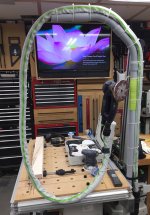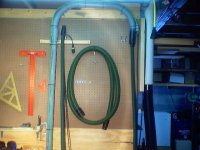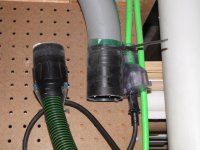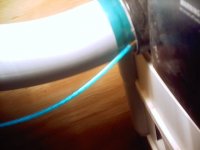guitarchitect
Member
- Joined
- Feb 6, 2017
- Messages
- 76
So here's one for the people that are smarter than me: In order to dissipate static at the vacuum, how important is it for the whole "chain" - from tool end to hose to vac-end to vac - to be anti-static?
We have probably all experienced the frustration that is the 36MM anti-static hose with a tracksaw - it makes me want to scream. It's stiff as hell and gets caught on the things that at first you thought "nah, that's out of the way, the hose won't get caught on that". I can't tell you how many cuts I've had to pause in the middle of in order to fight with the hose.
So my thinking is that if you had a piece of AS hose into the vacuum, and then an extension piece that is non-AS, will the AS hose still dissipate static through the vac? Taking this to its logical conclusion - what if you just took a regular hose but stuck the antistatic connector on the end of it? Or just had a nubby 2' section of AS hose at the vac?
I'm 100% on board with hanging my hose from the ceiling/on a boom arm, once I've built a workbench to stick my CT26 under... but like many other people I don't want to pay through the nose for a festool 5m hose, and I live in a climate that has very dry times of year and I do need the benefit of an antistatic hose so I don't fry my CT26. So I'm just wondering if I'm out to lunch or if it's a possible solution!
We have probably all experienced the frustration that is the 36MM anti-static hose with a tracksaw - it makes me want to scream. It's stiff as hell and gets caught on the things that at first you thought "nah, that's out of the way, the hose won't get caught on that". I can't tell you how many cuts I've had to pause in the middle of in order to fight with the hose.
So my thinking is that if you had a piece of AS hose into the vacuum, and then an extension piece that is non-AS, will the AS hose still dissipate static through the vac? Taking this to its logical conclusion - what if you just took a regular hose but stuck the antistatic connector on the end of it? Or just had a nubby 2' section of AS hose at the vac?
I'm 100% on board with hanging my hose from the ceiling/on a boom arm, once I've built a workbench to stick my CT26 under... but like many other people I don't want to pay through the nose for a festool 5m hose, and I live in a climate that has very dry times of year and I do need the benefit of an antistatic hose so I don't fry my CT26. So I'm just wondering if I'm out to lunch or if it's a possible solution!




